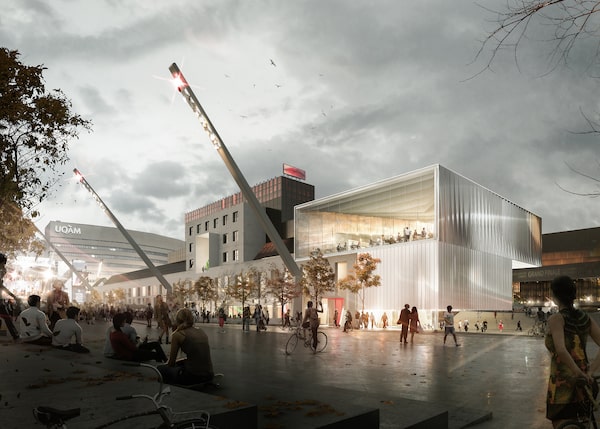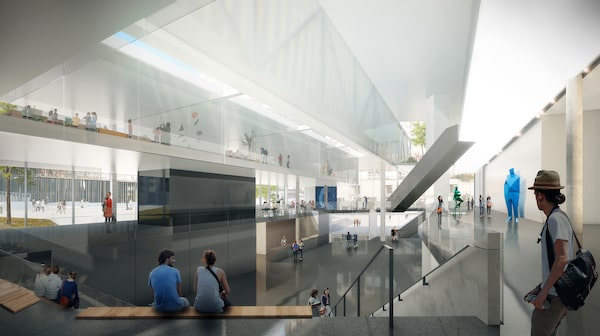
Completion of the renovation, MAC director and chief curator John Zeppetelli said, has probably been pushed back to 2023 or 2024.Saucier+Perrotte Architectes/GLCRM & Associes Architectes
On June 20, five months after closing its doors to prepare for a $44.7-million renovation, the Musée d’art contemporain de Montréal reopened a building that hasn’t changed in the least little bit. Unanticipated problems put the brakes on construction, which was to have begun this summer. Instead of exhibiting off-site until 2021, as originally planned, the MAC will stay home until further notice.
A detailed plan for the renovation was unveiled with great fanfare in April, 2018 – two years after provincial and federal governments committed $37.6-million to the project. Quebec’s Culture Minister and the mayor of Montreal came to hear John Zeppetelli, MAC director and chief curator, say that "Montreal will finally have a jewel that lives up to its ambitions, its reputation and its artistic importance.”
That word “finally” was a veiled allusion to the 16 years the MAC had spent trying to find a bigger home elsewhere, or to muster support for a larger rebuild on its current site at Place des Arts. But the end of this saga will take even longer to achieve than anyone imagined last year.
Robert Lepage’s new theatrical home in Quebec City reveals first seven productions
The MAC is owned by the province, which had final approval on the design through its Société québécoise des infrastructures (SQI). By December, however, the estimated cost of carrying out the project had risen by $8-million. The museum’s board quietly pressed the pause button.
A few weeks later, the MAC released a statement saying that the partners involved had “reviewed the schedule” for construction, and that the start date of this summer was no longer valid. “The MAC is thrilled to announce,” the museum said, straining to preserve an upbeat tone, “that it will continue to offer its activities in its current facilities on St. Catherine Street until fall 2020.”
That prediction is also no longer valid. In a recent phone interview, Zeppetelli said that a new starting date for construction has yet to be determined. Completion of the renovation, he said, has probably been pushed back to 2023 or 2024.
Saucier + Perrotte Architectes and GLCRM & Associés Architectes, the consortium that won the renovation design competition in 2017, did much more than review the schedule for the build. They spent months reanalyzing the entire design, trying to find ways to realize their plan for less.
“We totally reworked the way we’re going to approach construction,” lead architect Gilles Saucier said in a phone interview. “But we kept the soul and flavour of what we had before.”

The museum’s location made it hard to schedule the work economically.Saucier+Perrotte Architectes/GLCRM & Associes Architectes
The estimated cost overrun wasn’t due to some engineering glitch in the original plan, Saucier said. A hot construction market in Montreal has pushed prices for building and labour higher across the board, he said, and the museum’s location made it hard to schedule the work economically.
“This building is in the middle of the Quartier des Spectacles,” Saucier says. “It’s a very busy place in the summer, which is also construction season. You can imagine how difficult it is to get the permission for trucks, and you have to stop when the [jazz] festival is on.”
The museum is right next to the Place des Festivals, a prime site for outdoor concerts in summer.
There’s nothing new, however, about the problems of building at Place des Arts when the area teems with outdoor entertainments. On that front, the work schedule, as approved by the SQI last year, was evidently less than a carefully detailed plan.
Ballooning rates for construction work would have been harder to predict. Saucier said that he and his team had to re-examine the basic structure of their design to find the savings they were looking for.
“One solution was to keep much more of the existing concrete structure, which will save time and money,” Saucier said. Retaining more of the building’s internal skeleton will mean less demolition, and less rubble to haul away, he explained.
A few components of the original plan were reshuffled. Some basement storage rooms, which were to be converted to exhibition spaces, will stay as they are, while another part of the building takes on an exhibition function.
“We now have a new large exhibition space at the top of the building,” Saucier says. “It was to have been used for events, but it became an exhibition space, with exactly the same volume. So we don’t need to spend money changing the rooms in the basement, which can be kept as a provision for future development.”

The museum is right next to the Place des Festivals, a prime site for outdoor concerts in summer.Saucier+Perrotte Architectes/GLCRM & Associes Architectes
The dramatic changes to the exterior of the museum’s southern end survived the revision process, Saucier said. A three-storey glass atrium, a garden restaurant that will overhang the entrance plaza and a system of twisting vertical louvres along the glass second-floor wall will all be part of the final project. The concrete, fortress-like façade the museum now presents to the neighbourhood will be much more transparent.
“We wanted to change our relationship with Saint Catherine Street, develop a much more welcoming environment for visitors, and crucially, to double our exhibition surfaces,” Zeppetelli said. All of that will be delivered by the revised project, he said.
“It initially felt slightly catastrophic,” Zeppetelli said, referring to the cost crisis that came to light last winter. “But I think we have a much stronger design now. The delay turned out to be a really good thing.”
His immediate task when the problem arose was to decide what to do about the MAC’s summer programs. Those had already been sketched out for presentation off-site.
“We were just about to sign a lease for another location, that we very regrettably had to pull away from,” he said. “That was not fun for anybody.”
That other location was the Darling Foundry, an independent arts complex in a former industrial building in Old Montreal. After months of preparing the way for the MAC to take over her space, Foundry general director Caroline Andrieux learned a week before Christmas that the deal was off, leaving her with an empty schedule where MAC programming was supposed to happen.
“It was a bit traumatic for us,” Andrieux said in an interview. “We were very open to having them here. We spent a lot of time, and a lot of energy, organizing things for them. We postponed exhibitions.”

A three-storey glass atrium, a garden restaurant that will overhang the entrance plaza and a system of twisting vertical louvres along the glass second-floor wall will all be part of the final project.Saucier+Perrotte Architectes/GLCRM & Associes Architectes
Part of Andrieux’s preparation involved finding site-specific exhibitions she could do elsewhere while the MAC had the run of the Foundry. She was determined to maintain a full exhibition program off-site, even though the arts councils that support the Foundry told her it was a risky challenge.
“For us, it would have been interesting to see how new eyes would work with this rough space, what they could do here with a lot of money,” Andrieux said. “It would also have given the Foundry a higher profile, brought more audience to our space, more focus and more interest. I really respect the staff at the MAC. I still think it could have been a good deal for us.”
She asked the MAC for compensation; they gave a third of what she asked.
“It was okay, we just wanted to turn the page,” she says.
The MAC also took with them a show Andrieux had secured, as part of the biennial Momenta photography festival in September: a multiscreen projection by Francis Alys. The Darling Foundry will no longer be involved in Momenta this time, she said.
With the Foundry no longer in the picture, and the MAC’s own larger spaces back in his hands, Zeppetelli found “the interruption allowed us the freedom to respond to sudden enthusiasms. We’re really happy to have [the Art Gallery of Ontario’s Rebecca Belmore: Facing the Monumental], which we probably wouldn’t have taken, because we would have had other projects lined up. The show was very successful in Toronto, we’re huge admirers of her work and we had been courting her for a while anyway.”
MAC head of exhibitions Lesley Johnstone said that “we had to rethink a little bit, because what was going to be at the Foundry was a single project.” The museum’s summer offerings, which opened cios 20, include an exhibition of work by Nadia Myre, a joint installation by Chloe Lum and Yannick Desranleau, and a six-hour video collaboration by Ragnar Kjartansson and the band the National that showed during the MAC’s Kjartansson exhibition three years ago.
Andrieux said that once she had gotten over her dismay when the MAC contract fell through, she came to see it as “a liberation.” The Foundry’s summer shows, which opened June 13, include a site-specific project by Barbara Steinman and a show of whimsical constructions by Pascale Théorêt-Groulx, a resident artist at the space.
In September, as the MAC hosts Alys’s 18-screen video project, Children’s Games, the Darling Foundry will show Two ways to disappear without losing the physical form, by Chilean artist Javier Gonzalez Pesce; and Resisting Paradise, Puerto Rican curator Marina Reyes Franco’s choice of Caribbean works by Joiri Minaya, Leasho Johnson and Deborah Anzinger.
For now, both institutions have found reason to feel okay about the alarms and second thoughts that prevented the MAC’s renovation from getting physical this summer. Stay tuned for the actual date when the MAC’s dream of better quarters may finally begin to come true.
Live your best. We have a daily Life & Arts newsletter, providing you with our latest stories on health, travel, food and culture. Sign up today.